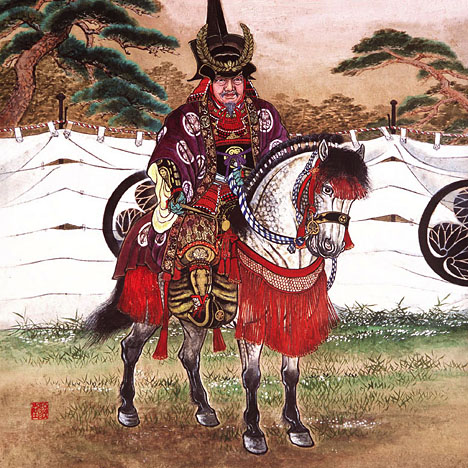Tokugawa Ieyasu was granted by the Japanese emperor, the title of shogun in 1603; his family was to rule Japan until 1867. In 1605, his son, Tokugawa Hidetada, officially took the office of the shogun, but Ieyasu remained the ruler from behind the scenes until his death.
Reared in an atmosphere of unrelenting civil war among different clans of Japan during the Warring States Era, Ieyasu was a remarkable unifier of competing interests among warring vassals, and a leader who brought relative peace to a land torn by centuries of civil war.
Ieyasu is remembered for his brilliant stratagems, his compassion for those enemies who accepted his authority, his skill in managing the rivalries of his generals, his commitment to keep Japan united, and his patience. He laid the foundations of a political, economic, and social system that was to lead to a century of dynamic growth in Japan.
  |
Ieyasu started his political career as a vassal of Toyotomi Hideyoshi, from whom he learned about governance, military planning, and management of state affairs. After Hideyoshi’s death, Ieyasu led a coalition of vassals against a rival group in the bloody Battle of Sekigahara, where he was victorious in 1600. He later got rid of Hideyoshi’s young heir. He already was the master of vast tracts of military holdings in eastern Japan.
Entirely ignoring the authority of the imperial court, he established his central headquarters in edo (Tokyo); thus, the Tokugawa period is also known as the Edo era in Japanese history. He built a massive fortified castle with huge concentric moats in Edo; it is the Imperial Palace today. From here, Ieyasu used his military strength to reorganize Japan and to establish a government system called the bakufu.
Centralized Rule
The system of rule that Ieyasu established was begun by his two predecessors in the 16th century. Because it was based on centralized control over daimyo (vassal) domains, it is called a feudal structure, though uniquely Japanese.
Ieyasu sought stability for Japan and dominance for himself among the landed aristocracy. He demonstrated administrative skill that matched his military abilities. First, he redistributed the lands of the vassals. His enemies’ lands were confiscated and distributed to his allies as rewards in an organized way.
 |
| Tokugawa Ieyasu as supreme command at the battle of Sekigahara |
He kept about a quarter of the confiscated domains under his family, the remainder distributed depending on the seniority and allegiance to other clans. The reallocation of about 265 domains ensured allegiance to the Tokugawa clan and stability.
Moreover, he placed his most trusted vassals to keep a close eye on others whose allegiance was undependable. Ieyasu issued a code of behavior called Buke Sho-Hatto, or Ordinances for the Military Houses, which limited the power of the feudatories in personal, civil, and economic spheres. It required them to seek permission from the shogun or his representative for all important activities.
Shogun Ieyasu amassed a huge fortune for the Tokugawa clan. This included property rights over commercial cities and trading ports such as Nara, Nagasaki, Osaka, Kyoto, Edo, and Yamada. He also owned profitable gold and silver mines and controlled the circulation of all the gold and silver coinage in the country.
   |
In a surprising turn of events between 1611 and 1614, Ieyasu issued ordinances prohibiting all teaching and practice of Christianity in Japan, deeply affecting political and economic relations of the Japanese, Portuguese, and Dutch, and moved toward seclusion. However, this seclusion did not hurt Japan’s economy, as domestic commerce was robust and vigorous.
Tokugawa Ieyasu was a wealthy but frugal man. His sense of discipline directed his efforts in ensuring calm and peace for Japan after the civil war. By the time he died at 74, he had established his family’s de facto rule, which was to last for over two centuries. In so doing, he completed the process of reestablishing national unity by a combination of military and civilian talent that amounted to genius.
